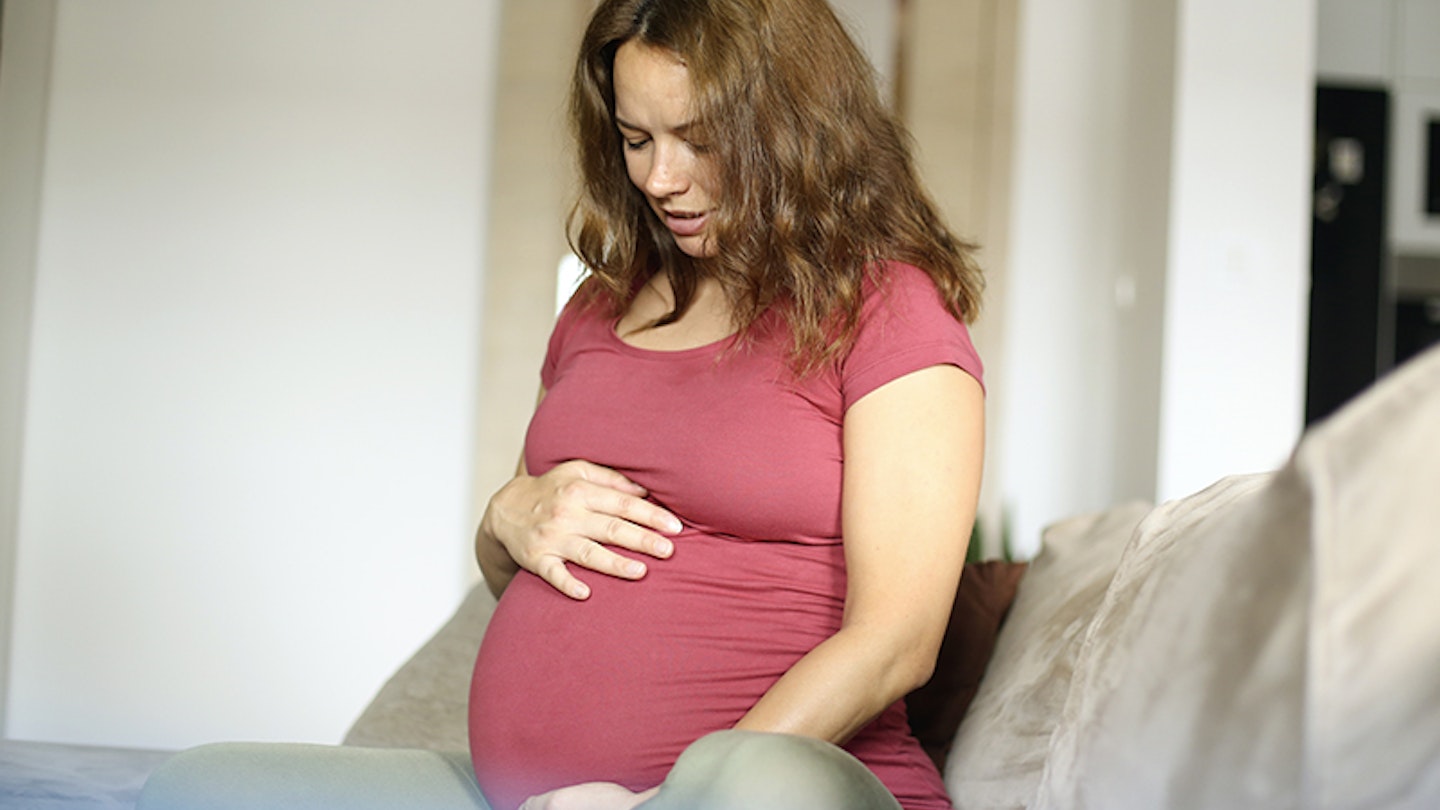Once you start showing in pregnancy you'll discover new things about your changing belly all the time - a term you may hear is diastasis. Diastasis Rectus Abdominis is tummy muscle separation, or tummy gap. These terms describe the opening and thinning of a small connective tissue which runs down our midlines. This is called the linea alba. It divides our six pack muscles into two - from our sternum to our pubic bone. As the tissue broadens, the two halves of the six pack muscle move further apart. This is where the term ‘tummy muscle separation’ comes from.
The widening and thinning of our linea alba is a normal part of pregnancy and occurs in the third trimester. 100% of pregnant women will have some experience of diastasis at some point. This is really important because it enables our bellies to expand, and make space for our growing baby before birth.
Pregnancy hormones play a large role in this process as they help to soften our connective tissues and ligaments. Along with helping the linea alba to become more pliable, pregnancy hormones will also help to soften the ligaments around the pelvis, preparing your body for labour.
We spoke to Dr Deborah Lee, Dr Fox Online Pharmacy, who said: "Diastasis rectus abdominis (DRA) is very common and occurs to some degree or other in all pregnant women. It is also sometimes called ‘separated stomach muscles.’
The abdominal wall - your six-pack - is a group of 4 layers of muscles that are held together by a band of connective tissue called the linea alba. The enlarging pregnancy stretches the linea alba so it becomes stretched, so it thins out and becomes less competent. Also, the hormone relaxin, which is produced in pregnancy, softens tendons and ligaments.
In one study, DRA was present in 70% of women during the last trimester of pregnancy, 60% at 6 weeks after delivery and 30% at 12 months after delivery, Dr Deborah Lee says.
Note that in DRA, there is no physical defect in the linea alba and this is not serious. However, in extreme cases, the linea alba may tear, allowing visceral fat or bowel to protrude through it, causing a rectus sheath hernia. In this case, surgery may be indicated.
Risk factors
The following risk factors make DRA more likely -
• Pregnancy – especially twin or multiple pregnancies
• Giving birth multiple times
• Small build
• Vaginal delivery
• Chronic strain on the abdomen - such as cough, vomiting, or constipation
• Poor lifting techniques
• Excessive abdominal exercises
• Family history of DRA
• In men, it is associated with weightlifting
In one study, DRA in 2015 found no link between themselves and maternal obesity or the baby's birth weight.
Symptoms and signs
Often RDA can be present with no symptoms. It may be uncomfortable but should not be painful. You might feel your tummy is soft and jelly-like where it used to be firm, says Dr Deborah Lee.
You may notice during or after the pregnancy, that when you strain your abdominal muscles, you can see a bulge in the midline that didn’t used to be there. However, it may be associated with low back pain, pelvic pain or pelvic floor dysfunction – resulting in painful sex and urinary incontinence. Women often feel unhappy about it and it can cause low self-confidence and lower self-esteem.
If you want to know if you have it, lie on your back with your knees bent and feet flat on the floor. Raise your head and look at your tummy. This does not mean doing a sit-up. Look for any ‘doming’ of the tummy wall. You might see a tent or dome-shaped bulge in the upper part of the tummy above the belly button.
Put your fingers into the longitudinal gap between your abdominal muscles above and below the belly button. See how many fingers you can fit into the gap. It should be 2-3 finger breadths – or 2.5 cm or less. After having a baby the gap may well be wider than this but should shrink to be back to near normal by 8 weeks after childbirth. There are exercises you can do to help to disappear. After this time, if this hasn’t happened, see your GP or a physiotherapist.
If the diagnosis is in doubt, DRA can be diagnosed using abdominal ultrasound or a CT scan. This enables the exact measurements of the defect in the linea alba to be measured.
Weeks 1-6 after childbirth
You can reduce your chance of a persistent DRA by doing the following in the first 6 weeks after childbirth. This will encourage it to resolve naturally.
• Try to rest and avoid carrying heavy things as much as possible. When you do carry something heavy, bend your knees before lifting, consciously tense your abdominal muscles before lifting, and hold it close to you, not at arm's length, continues Dr Deborah Lee.
• Get into bed by lowering yourself onto your side, then rolling onto your back. When getting out of bed do the reverse. This avoids straining the abdominal muscles.
• Don’t allow yourself to get constipated. Keep up your fibre intake and drink plenty of water. Ask your GP for help if this is a problem – you might need laxatives if you are healing from an episiotomy or an anal tear.
• Try to avoid coughing. If you have a cough, do what you can to reduce it. Take any asthma or anti-allergy medicines appropriately. Don’t smoke. You are strongly advised not to smoke in pregnancy, or anywhere near or around a new baby. Ask your GP for help to ensure you’ve quit and quit and quit for good.
Exercises that can help DRA
Here are a couple of exercises to help strengthen the abdominal muscles and encourage DRA to improve. These are designed to strengthen your core muscles -
• Breathing using abdominal muscles
Put one hand on your tummy.
Breathe in, and as you breathe out, tighten your tummy muscles.
Then relax your tummy muscles as you breathe in and tighten them again as you breathe out.
Repeat ten times.
• Pelvic tilt
Sit, or lie down. Breathe in, and as you breathe out, draw in your abdominal and pelvic muscles, but flatten your spine so you are pressing it into the back of the chair or the bed. This means tipping your pelvis backwards.
Next, breathe in, relax your abdominal and pelvic muscles and consciously move your pelvis forward.
Repeat this 20 times.
Note that these exercises should not be painful. If they cause pain, or things are not improving, see your GP or a physiotherapist, adds Dr Deborah Lee.
If you are referred to a physiotherapist, they may suggest you wear an elasticated abdominal support around the abdomen and lower back.
Things that can make DRA worse
Take care not to do any exercises that put specific strain on your anterior abdominal muscles
• Crunches, sit-ups
• Planks
• Downward Dog and some other yoga moves
• Some Pilates moves such as double leg lifts and scissors
Other treatments for DRA
The mainstay of treatment for DRA is physiotherapy. Rarely, DRA is treated by surgery. It is only offered to those with severe symptoms who have failed to respond to physiotherapy after 6 months.
When to see your GP
DRA is not serious but it can cause distress and may be linked to other problems. If it is at least 8 weeks since your delivery and you can get more than 2 fingers into the linea alba gap, or if you have any discomfort or other symptoms such as low back pain, pain in the pelvic region, painful sex or incontinence – see your GP. You may be referred to a specialist women's health physiotherapist, says Dr Deborah Lee.
Meet the expert:

Having worked for many years in the NHS, mostly as Lead Clinician within an integrated Community Sexual Health Service, Dr Deborah Lee now works as a health and medical writer, with an emphasis on women's health, including medical content for Dr Fox pharmacy. She has published several books and remains passionate about all aspects of medicine and sexual health. After completing her Medical Degree at University of Southampton Medical School in 1986, Dr Leetrained as a GP and after a number of years specialised in Sexual & Reproductive Health (S&RH).
Mummy to a little girl, Adejumoke Ilori is Commercial Content Writer for Mother&Baby. With a BA hon in Creative Writing, she has worked for digital platforms, where she has empowered women from the inside and out, by sharing real life stories based on relationships, loving yourself and mummyhood.
